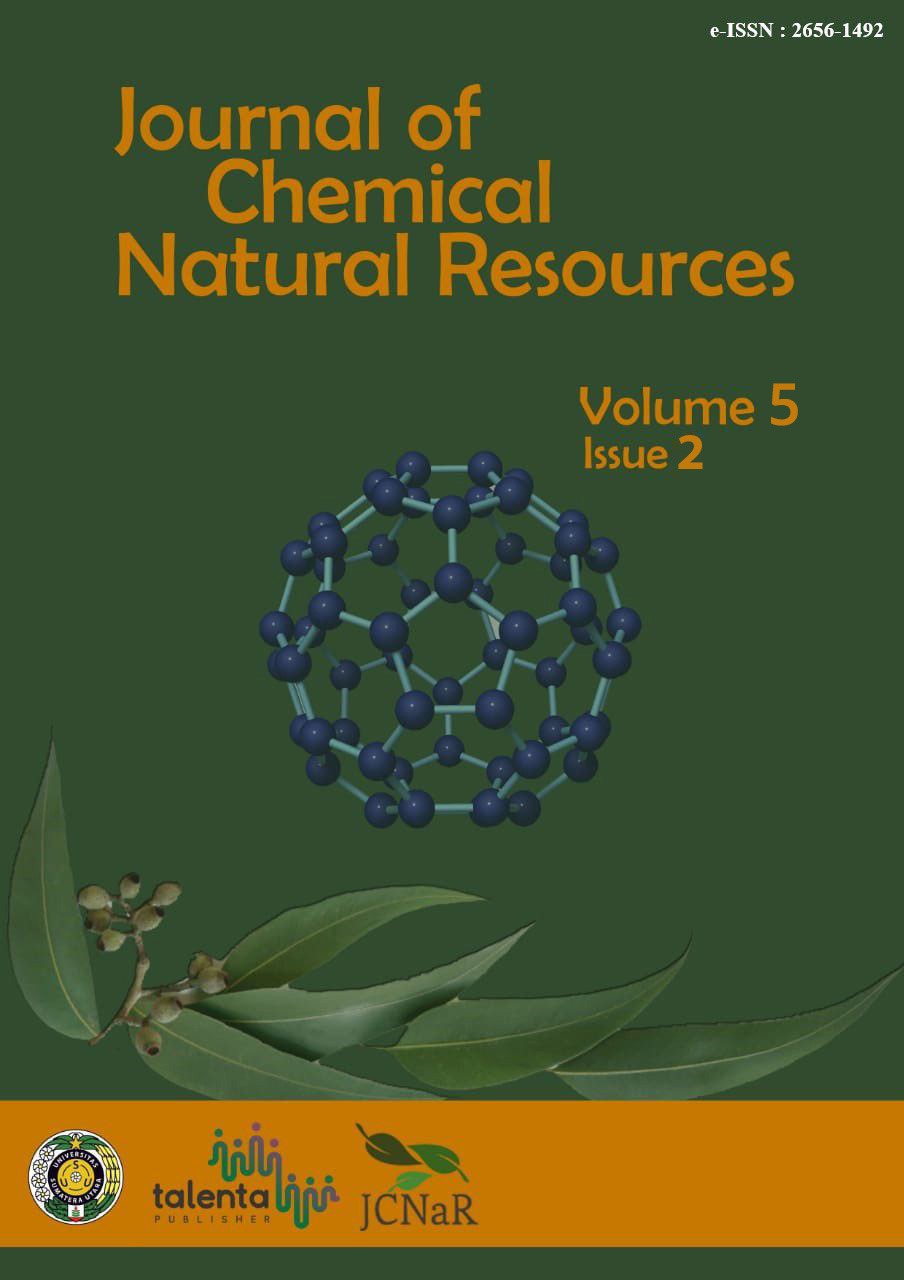Isolation and Identification of Flavonoid Compounds and Antibacterial Activity Test of the Canyere Badak Plant (Bridelia glauca Blume) (Phyllanthaceae)
DOI:
https://doi.org/10.32734/jcnar.v5i2.13816Keywords:
Antibacterial Activity, Canyere Badak Plant, Flavanoid, Isolation, , SpectroscopyAbstract
Flavonoid compounds from the stem bark of the Canyere Badak plant (Bridelia glauca Blume) have been isolated. 2500 g of Canyere Badak plant stem bark was macerated by methanol, and the methanol extract dissolved in distilled water. The distilled water solution was extracted by partitioning with ethyl acetate repeatedly until negative to 5% FeCl3. The ethyl acetate extract was dissolved in methanol and extracted by partitioning with n-hexane until the n-hexane layer was transparent. The methanol extract was analyzed by thin layer chromatography and separated by column chromatography with a stationary phase of silica gel and a mobile phase of chloroform: methanol (90:10; 80:20; 70:30; 60:40) v/v. Fractions 148-174 were purified by preparative thin layer chromatography using benzene: acetone (80:20) v/v eluent to produce a brownish yellow paste of 10 mg at Rf value of 0,66 using chloroform: methanol (80:20) v/v as eluent. Based on the analysis of the UV-visible spectrophotometer, it had a wavelength (λ max) of 275 nm. The FT-IR spectrum shows the presence of OH, C=C aromatic, C=O ketones, C-H, C-O-C and C-O groups. The proton Nucleus Magnetic Resonance Spectrum (1H-NMR) indicates the presence of H-2’ & H-6’ protons, H-3’ & H-5’ protons and methoxy protons. Based on the data analysis and interpretation, the isolated compound was a flavonoid of the flavanones group. The antibacterial activity of total flavonoids was determined by agar disk diffusion against Staphylococcus aureus and Escherichia coli bacteria. The results showed that total flavonoids strongly inhibited the growth of Staphylococcus aureus and Escherichia coli bacteria with MIC (Minimum Inhibitory Concentration) value at a concentration of 100 mg/mL obtained a clear zone of 9.5 mm against Staphylococcus aureus bacteria and at a concentration of 100 mg/mL obtained a clear zone of 12.15 mm against Escherichia coli bacteria.
Downloads
References
H. P. S. Makkar, G. Francis, and K. Becker, “Bioactivity of phytochemicals in some lesser-known plants and their effects and potential applications in livestock and aquaculture production systems,†Animal, vol. 1, no. 9, pp. 1371–1391, Jan. 2007, doi: 10.1017/S1751731107000298.
M. H. sao, R., & Akhtar, “Nutraceuticals and functional foods: I. Current trend in phytochemical antioxidant research,†Int. J. Food, Agric. Environ., vol. 3, pp. 10–17, 2005.
Markham KR, Cara Mengidentifikasi Flavonoida. Terjemahan Kosasi Padmawinata. Bandung: ITB Press, 1988.
M. Heinrich, J. Barnes, S. Gibbons, and E. Williamson, Farmakognosi dan Fitoterapi. Jakarta: Penerbit Buku Kedokteran EGC, 2005.
T. A. Ngueyem, G. Brusotti, G. Caccialanza, and P. V. Finzi, “The genus Bridelia: A phytochemical and ethnopharmacological review,†J. Ethnopharmacol., vol. 124, no. 3, pp. 339–349, Jul. 2009, doi: 10.1016/J.JEP.2009.05.019.
A. R. Zarta, F. Ariyani, W. Suwinarti, I. W. Kusuma, and E. T. Arung, “Short communication: Identification and evaluation of bioactivity in forest plants used for medicinal purposes by the Kutai community of east Kalimantan, Indonesia,†Biodiversitas, vol. 19, no. 1, pp. 253–259, Jan. 2018, doi: 10.13057/BIODIV/D190134.
T.-H. Duong et al., “Sulfonic Acid-Containing Flavonoids from the Roots of Phyllanthus acidus,†journal Nat. Prod., vol. 81, no. 9, pp. 2026–2031, 2018, doi: https://doi.org/10.1021/acs.jnatprod.8b00322.
R. Risnawati, M. Muharram, and J. Jusniar, “Isolasi Dan Identifikasi Senyawa Metabolit Sekunder Ekstrak N-Heksana Tumbuhan Meniran (Phyllanthus niruri linn.),†J. Ilm. Kim. dan Pendidik. Kim., vol. 22, no. 1, 2021, doi: https://doi.org/10.35580/chemica.v22i1.21730.
F. H. Kayser, K. A. Bienz, and J. Eckert, “Color Atlas of Medical Microbiology.†new york: thieme, Stuttgart, 2005.
R. N. Prasad et al., “Short Communication, Preliminary phytochemical screening and antimicrobial activity of Samanea saman,†J. Med. Plants Res., vol. 2, no. 10, pp. 268–270, 2008.
A. Hermawan, “Pengaruh Ekstrak Daun Sirih (Piper betle L.) terhadap Pertumbuhan Staphylococcus aureus dan Escherichia coli Dengan Metode Difusi Disk. Artikel Ilmiah,†Universitas Airlangga Surabaya, 2007.
S. Kumar and A. K. Pandey, “Chemistry and biological activities of flavonoids: An overview,†The Scientific World Journal. 2013. doi: 10.1155/2013/162750.
J. E. Lakoro, M. R. J. Runtuwene, P. V. Y. Yamlean, P. Studi, F. Fmipa, and U. Manado, “Uji Aktivitas Antioksidan dan Penentuan Total Kandungan Fenolik Ekstrak ETANOL DAUN NANAMUHA ( Bridelia monoica Merr ),†Pharmacon, vol. 9, pp. 178–183, 2020.
D. L. Pavia, G. M. Lampman, G. S. Kriz, and J. R. Vyvyan, Introduction to Spectroscopy (4th ed), 4th ed. Belmont: Brooks/Cole Cengage Larning, 2001.
Harmita, Analisis Fisikokimia Kromatografi Vol.2. Penerbit Buku Kedokteran 2009, 2009.
Harmita, Analisis Fisikokimia: Potensiometri & Spektroskopi. Jakarta: Penerbit Buku Kedokteran EGC, 2015.
T. J. Mabry, K. Markham, and M. Thomas, The Determination and Interpretation of NMR Spectra of Flavonoids, 1st ed. Springer, 1970.
M. Radji, Buku Ajar Mikrobiologi Panduan Mahasiswa Farmasi dan Kedokteran. Jakarta: Buku Kedokteran EGC, 2011.

Downloads
Published
Issue
Section
License
Copyright (c) 2023 Journal of Chemical Natural Resources

This work is licensed under a Creative Commons Attribution-ShareAlike 4.0 International License.














